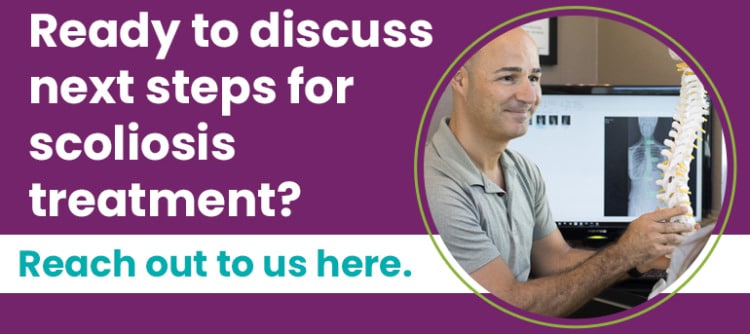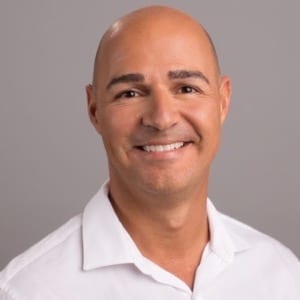When Was Scoliosis First Discovered? Exploring Its Evolution
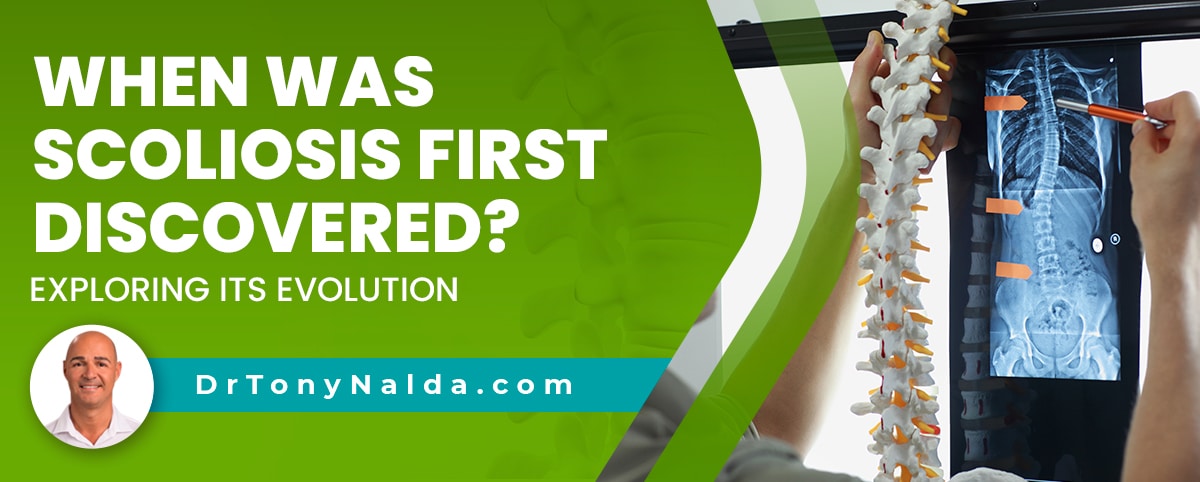
Scoliosis has been around since ancient times, and while there is a lot we still don't understand about the condition, treatment has evolved to include conservative non-surgical treatment with proven results. Scoliosis causes the spine to bend and twist unnaturally and is a progressive condition.
Scoliosis was first documented by Hippocrates in 400 B.C. The name scoliosis comes from the Greek work for crooked and was coined by Galen in 200 A.D. Scoliosis treatment has evolved from tying patients to sticks to spinal fusion surgery and the emergency of conservative non-surgical treatment.
Scoliosis was first documented by Hippocrates as a spinal deformity causing a curved spine.
Table of Contents
An Ancient Spinal Condition
Hippocrates is known as the father of medicine and was the first to document scoliosis as a problem involving a curved spine in 400 B.C.
The ancient Greeks had a basic understanding of how the condition affected the spine, but their understanding of its progressive nature and how to manage it was limited.
The term scoliosis was coined by Greek physician, surgeon, and philosopher, Galen in 200 A.D and comes from the Greek work skolios meaning crooked.
Early Greek treatment methods included pulling and stretching the spine in an attempt to straighten it, along with tying patients to sticks (precursor of traditional spinal fusion surgery).
From the ancient world to the 16th century, treatment focused on physical methods of straightening the spine, until the emergence of scoliosis bracing as a facet of treatment.
Scoliosis Bracing
Scoliosis bracing is a regular facet of modern childhood scoliosis treatment; bracing is also used in adult scoliosis treatment, but tends to have a different focus and is used more for short=term pain relief than augmenting corrective results.
Bracing is more effective on growing spines because they are more malleable, and when combined with other types of treatment, scoliosis bracing can help my pushing the spine into a corrective position, but it's also important to understand that not all scoliosis braces are created equal.
And just as the treatment of scoliosis in general has evolved and changed drastically over the years, so too have bracing efficacy and options.
In the 16th century, bracing was introduced as a scoliosis treatment option by Dr. Ambrose Paré (regarded as one of the fathers of modern surgery), but they were in the form of iron corsets that were uncomfortable to wear and didn't address the rotational deformity within the spine.
The 1970s saw the creation of the most widely-used traditional scoliosis brace: the boston brace. However, we now know that this brace is limited in its potential efficacy, not only because it's associated with a traditional treatment response, but also because it doesn't address the condition's true 3-dimensional nature and has low rates of compliance.
The modern ScoliBrace was developed in 2011 to address the shortcomings of traditional bracing and represents the culmination of what we've learned about scoliosis and bracing efficacy over the years.
Modern Scoliosis Treatment in the 19th Century
Modern scoliosis treatment today offers a non-surgical approach that combines the power of exercise, bracing, and chiropractic care, but before we got here, the place of exercise in scoliosis treatment was unclear and often questioned.
The early 19th century saw medical professionals suggesting that exercise could strengthen back muscles and counteract progression; these early thinkers included Per Henriq Ling, Albert Sayre, and Gustav Zander.
The first full exercise-based approach to treating scoliosis is known as the Schroth Method, created by Katarina Schroth who suffered from scoliosis and the limited treatment options of the time; after attempting to correct her scoliosis with a steel brace commonly used at the time, Schroth decided a more functional approach was needed.
The Schroth method is the most widely-used exercise-based approach to scoliosis treatment today and involves combining breathing techniques, muscle strengthening, and postural awareness/remodeling, largely through the use of mirror-image exercise.
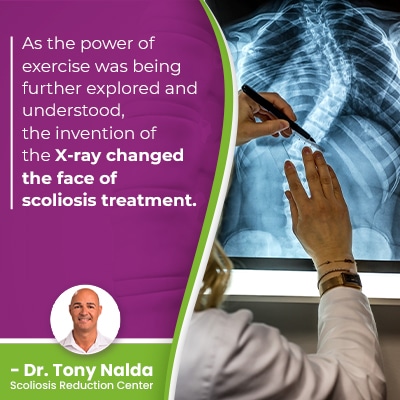 As the power of exercise was being further explored and understood, the invention of the X-ray changed the face of scoliosis treatment.
As the power of exercise was being further explored and understood, the invention of the X-ray changed the face of scoliosis treatment.
The Modern X-Ray and Scoliosis Treatment
The modern X-ray was discovered around 1895, and this changed the way scoliosis was understood and treated.
X-rays allow us to fully see what's happening in and around the spine. Currently, scoliosis can't be diagnosed without an X-ray that confirms the spine's rotational component and determines condition severity.
The early 1930s saw the advent of the Cobb angle measurement: the gold standard in scoliosis assessment and diagnosis.
J.R. Cobb came up with a measurement that could determine how far out of alignment a scoliotic spine was, and this is a key piece of information that treatment plans are shaped around.
The higher a patient's Cobb angle, the more severe the condition is: mild scoliosis, moderate, severe, and very severe scoliosis.
The advent of the X-ray also allowed for surgical attempts at fixing scoliosis to be more specific and timed once a certain severity level is reached.
Spinal Fusion Surgery
The first spinal fusion surgery performed in the United States took place in 1914 and was performed by Dr. Russell Hibbs.
Spinal fusion, also known as scoliosis surgery, is performed with the goal of preventing further progression, and it involves determining the curve's most-tilted vertebrae, removing intervertebral discs that sit between adjacent vertebrae to be fused, and fusing the vertebrae into one solid bone so they can't become more tilted over time.
The 1950s saw the invention of the Harrington rod and its use in spinal fusion surgery, and the rod used a hood and ratchet system to attach to the spine.
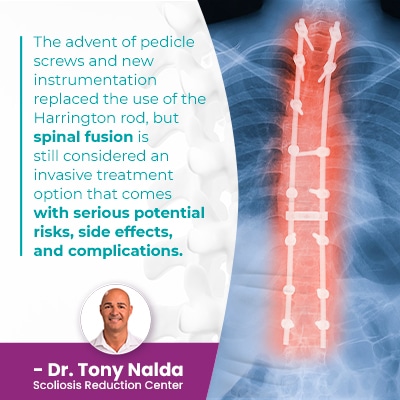 The advent of pedicle screws and new instrumentation replaced the use of the Harrington rod, but spinal fusion is still considered an invasive treatment option that comes with serious potential risks, side effects, and complications.
The advent of pedicle screws and new instrumentation replaced the use of the Harrington rod, but spinal fusion is still considered an invasive treatment option that comes with serious potential risks, side effects, and complications.
Modern Conservative Treatment
The conservative treatment of scoliosis involves a proactive non-surgical response, and it's an integrative and innovative approach with proven results.
In the early 2000s, SOSORT was established: the Scientific Society on Scoliosis Orthopaedic and Rehabilitation Treatment.
Exercise-based approaches to scoliosis treatment such as the Schroth method and SEAS (Scientific Exercises Approach to Scoliosis) have proven results, and when combined with the power of chiropractic care, conservative treatment of scoliosis can be highly effective.
While there are never treatment guarantees, when a scoliosis diagnosis is responded to immediately with proactive conservative treatment, the condition can be highly treatable, particularly with early intervention.
Here at the Scoliosis Reduction Center®, patients benefit from a proactive non-surgical treatment approach that combines the power of exercise, corrective bracing, chiropractic care, physical therapy, and rehabilitation programs.
Chiropractic care involves a series of techniques and manual adjustments that work towards spinal manipulation and adjusting the position of the curve's most-tilted vertebrae back into alignment with the rest of the spine: restoring as much of the spine's healthy curves as possible.
Exercise and physical therapy is used to improve the balance and strength of the spine's surrounding muscles for better spinal support and stability, and it can also help improve postural and brain-body communication.
Corrective bracing is used to augment corrective treatment results by pushing the spine into a straighter alignment, and rehabilitation is the ongoing portion of treatment because as a progressive condition, efforts need to be made to sustain treatment results and lead a spine-friendly lifestyle.
Conclusion
When it comes to the evolution of scoliosis treatment, we have come a long way from ancient treatment involving tying scoliosis patients to sticks and stretching the spine to spinal fusion and the rise of conservative treatment options.
The advent of conservative treatment gives patients a less invasive treatment alternative, and particularly when it comes to addressing spinal disorders in scoliosis patients who have not yet reached skeletal maturity, being proactive is key.
As scoliosis progression is triggered by spinal growth, adolescent idiopathic scoliosis is the most at risk for rapid progression due to the unpredictable nature of pubescent growth spurts.
Where a scoliosis is at the time of diagnosis doesn't mean that's where it will stay; only proactive treatment can work towards counteracting the condition's progressive nature.
Untreated patients will likely continue progressing until they become severe, and the more severe and/or atypical a condition is, the more necessary future orthopaedic surgery is, but the reality is that many scoliosis patients don't need spine surgery.
Scoliosis curves that are mild are simpler to correct than moderate scoliosis and severe scoliosis, so starting treatment immediately following a diagnosis can mean addressing a spinal curve that's going to be more responsive.
Scoliosis causes a lateral curvature of the spine to develop, and curve progression needs to be prevented; regardless of condition type or severity, all scoliosis patients need to be taken seriously and require treatment.
With the Scoliosis Research Society putting current estimates at close to seven million people living with scoliosis in the United States alone, the condition is highly prevalent and warrants awareness.
What I want scoliosis patients to fully understand is that not all cases of scoliosis need surgery, and conservative treatment can minimize spinal trauma, condition effects, and the need for future surgical attempts at correction.
Dr. Tony Nalda
DOCTOR OF CHIROPRACTIC
After receiving an undergraduate degree in psychology and his Doctorate of Chiropractic from Life University, Dr. Nalda settled in Celebration, Florida and proceeded to build one of Central Florida’s most successful chiropractic clinics.
His experience with patients suffering from scoliosis, and the confusion and frustration they faced, led him to seek a specialty in scoliosis care. In 2006 he completed his Intensive Care Certification from CLEAR Institute, a leading scoliosis educational and certification center.
About Dr. Tony Nalda
 Ready to explore scoliosis treatment? Contact Us Now
Ready to explore scoliosis treatment? Contact Us Now